Drain cleaner
A drain cleaner is a chemical-based consumer product that unblocks sewer pipes or helps to prevent the occurrence of clogged drains. The term may also refer to the individual who performs the activity with chemical drain cleaners or devices known as plumber's snake. Drain cleaners can be classified in two categories: either chemical or mechanical.
- If a single sink, toilet, or tub or shower drain is clogged, the first choice is normally a drain cleaner that can remove soft obstructions such as hair and grease clogs that can accumulate close to interior drain openings. Chemical drain cleaners, plungers, handheld drain augers, air burst drain cleaners, and home remedy drain cleaners are intended for this purpose.
- If more than one plumbing fixture is clogged the first choice is normally a drain cleaner that can remove soft or hard obstructions along the entire length of the drain, from the drain opening through the main sewer drain to the lateral piping outside the building. Electric drain cleaners and sewer jetters are intended for this purpose.
Each type of drain cleaner has advantages, disadvantages, and safety considerations as described below.
Chemical drain cleaners
Chemical drain cleaners can be in solid or liquid form that are readily available through hardware stores, though some (primarily acidic ones) are intended for use by licensed plumbers.[1]
Alkaline drain cleaners are available in either solid or liquid state while the acidic ones are usually in liquid form.
History
The history of drain cleaners necessarily shares a relationship with the evolution of the drain systems themselves, and so there is not an extensive history of cleaners in the US, as municipal plumbing systems were not readily available in middle-class American homes until the early 20th century. Prior to this time, Americans often discarded the dirty water collected in basins after use. Limited piping systems gradually developed with lead materials, but after WWI when the poisonous properties of lead became more well-known, piping was reconstructed with galvanized iron.
Galvanized iron is actually steel covered in a protective layer of zinc, but it was soon discovered that this zinc layer naturally corroded due to exposure to the atmosphere and rainwater, as well as cement, runoff, etc. Once corrosion occurred down to the base metal, plaques and rust would form, leading to sediment build-up that would gradually clog these drains. Thus, the first motivation for drain cleaners came to be.
The struggle against corroding galvanized iron pipes eventually led to a replacement by copper or plastic (PVC) piping by the 1960s. Copper and plastic do not possess that zinc layer that naturally corrodes to expose the base metal to decay. Still, however, natural substances such as hair, grease, or other oils continued to be an issue in drain clogs, and so, the development of more effective chemical drain cleaners became necessary.[2]
Alkaline drain openers
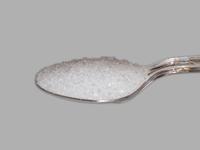
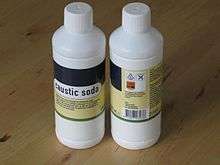
Alkaline drain openers primarily contain sodium hydroxide (lye) and some may contain potassium hydroxide. They may appear in liquid or solid form.
Solid formulations of corrosive alkaline drain cleaners are composed of a caustic substance (often sodium hydroxide or potassium hydroxide), aluminum particles, and 'additives.' These additives often include wetting agents such as alkyl aryl sulfonates, but the exact nature of these additives are not known for commercial drain cleaners, as they are regarded as the trade secrets that make each drain cleaner unique to its brand.
The aluminum granules that are included in the solid caustic drain cleaner is an aluminum oxide that breaks down and re-oxidizes to release hydrogen gas. The components of this reaction are shown below. Because the release of hydrogen gas is overall an exothermic reaction, the extra heat released helps to break down the greases, oils, etc. that form the clog.
1. Breakdown of Aluminum Oxide: Al2O3 + 2NaOH + 3H2O → 2Na [Al(OH)4]
2. Oxidation of Aluminum metal: 2Al + 2NaOH + 6H2O → 2Na[Al(OH)4] + 3H2
The actual breakdown of a clog occurs by reaction with the basic sodium hydroxide (lye). Clogs are often composed of natural substances such as hair, fats, oils, etc. and breakdown occurs via a saponification reaction of a base and triglycerol. Essentially, the hydroxide ions from the basic lye attack the carbonyl carbons of the fat, which eventually kicks off the hydrophobic tails of the triglyceride (tristearin/fat) to isolate glycerol.
Alkaline drain openers can dissolve hair (containing proteins) and fats inside pipes via alkaline hydrolysis of amide and ester respectively:
Because solid lye is hygroscopic, it is crucial that the solid granules of the cleaner are placed directly in proximity to the clog. Otherwise, the lye itself will absorb water and actually create a mass itself, exacerbating the clog issue.
Liquid formulations of corrosive alkaline drain cleaners can contain sodium hypochlorite (bleach) and lye (sodium hydroxide or potassium hydroxide) in concentrations up to 50 percent. Other corrosive mixtures come as two-part cleaners that are mixed as they are poured in the drain opening. Inside the drain the two solutions react to release a gas, and surfactants trap the gas as dense foam. The intent of this foaming action is to coat the inside of the drain pipe to dislodge more of the substances that form the clog. Because liquid alkaline drain cleaners are essentially a base dissolved in water, this is denser than water and can sink to the source of the clog.
Acidic drain openers
.jpg)
Acid drain cleaners usually contain sulfuric acid at high concentrations.[3] It can dissolve cellulose, proteins like hair, and fats via acid hydrolysis.
According to a manufacturer, potential hazards include violent reaction with water and the production of explosive hydrogen vapors upon contact with most metals; chronic (delayed) and acute (immediate) health hazards if inhaled, ingested, or contacted, including severe eye, flesh and skin burns or even permanent visual loss, inflammation of respiratory membranes, and corrosive burns to all human tissue. It may even be fatal if swallowed.[4] Due to the vigorous reaction between the acid and water, such acidic drain openers should be added slowly into the pipe to be cleaned.
Here are the ways where acidic drain openers (in very high concentrations) hydrolyze proteins and fats via acid hydrolysis, similar to their alkaline versions mentioned above:
Sulfuric acid at high concentrations in drain openers also dehydrates substances containing carbohydrates, like tissue paper which consists of cellulose:
- (C
6H
10O
5)n + acid → 6n C + 5n H
2O
Danger and Usage considerations
Advantages of chemical drain cleaners include ready availability of some formulations through retailer stores and potential ease of use for removing soft hair and grease clogs that accumulate close the drain openings.
Disadvantages of chemical drain cleaners include a lack of effectiveness for removing clogs far from the drain opening (for example, clogs that occur in toilets[5] or in the main sewer drain), an inability to remove most solid obstructions, and the safety considerations outlined below.
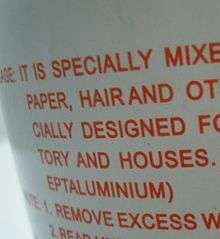
Danger arises from chemical drain cleaners' potential to injure eyes, lungs, and skin; and damage to clothing and household materials such as wood, paint, aluminum, and fiberglass. Chemical drain cleaners should be used only according to the manufacturer's instructions, as other use may cause injury.[6] Strongly corrosive and acid drain cleaners are among the most hazardous household products available to the public. Chemical drain cleaners can cause strong reactions—sometimes explosively—with other chemicals that may have been used previously, which can result in serious injury to anyone in the vicinity.[7] In one such incident, a five-year-old boy was left scarred for life after an acidic drain cleaner leaked through his bedroom ceiling as he slept.[8]
Strong Alkali Drain cleaners are equally capable of causing rapid, severe burns, as seen in the cases of a woman doused with concentrated lye in an attack. A small girl was also permanently disfigured by a common lye drain opener.[9], [10] Moreover, because the acidic or basic drain cleaners themselves are washed down the drain, this contributes to pollution in the water supply. The heat generation can also soften plastic PVC pipes, and the pressure buildup by gas generation can cause older pipes to burst. Commercial chemical based solutions can cause corrosion and other damage to your pipes and sewer lines[11]
Oftentimes, individuals may unknowingly mix two different types of drain cleaners, which can even lead to deadly results. For example, consider the mixing of an acidic and basic drain cleaner:
•Sulfuric Acid + Sodium Hydroxide (base) → sodium sulfate (salt) + water
H2SO4 + 2 NaOH → Na2SO4 + 2H2O
The neutralization reaction of the acid and base may seem harmless, but in reality this reaction is extremely exothermic and can cause pipes to violently explode. Consider another example of mixing, this time between an acid drain cleaner and bleach:
•Hydrochloric acid + bleach → water + table salt + chlorine gas
2HCl + NaClO → H2O + NaCl + Cl2
This reaction generates chlorine gas, which is commonly known to be poisonous.
Handheld drain augers
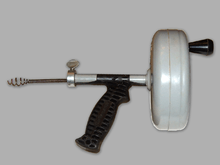
Handheld drain augers are typically designed to clean portions of a drain within 8 metres (25 ft) of the drain opening. The cable of a handheld drain auger is driven into a drain by the mechanical force created when the operator rotates a drum that anchors the cable.
Many handheld augers have cables that are thin enough to pass through common sink traps, though some manufacturers do not recommend using handheld drain augers in toilets because of their potential to scratch ceramic surfaces. Instead, a special closet auger (from "water closet") should be used.
Similar to handheld augers, drain rods can be used for clearing blockages in long, straight pipes.
Advantages of handheld drain augers include low relative cost and ready availability through hardware stores. However, drawbacks include a reach that is normally limited to 8 metres (25 ft), and the potential for the twisting cable to scratch the ceramic surfaces of plumbing fixtures. They are also only effective on small-diameter pipes – 40–50 mm rather than main sewer pipes of 110 mm.
Safety considerations include a requirement to wear protective gloves and eye protection, and to practice good hygiene after coming into contact with drain fluids.
Air burst drain cleaners
Air burst drain cleaners use accelerated carbon dioxide, air or other gas to rupture the clog membrane. Accelerated gas creates a force on standing water that can dislodge clogs that accumulate close to drain openings.
Advantages of air burst drain cleaners include the potential to immediately clear clogs and slow-running drains, in contrast to chemical cleaners that can take more time to work. Air burst cleaners can dislodge obstructions that are further away from drain openings than can a plunger, and in contrast to a drain augers do not risk scratching the ceramic surfaces of sinks, bathtubs and toilets.
Disadvantages of air burst drain cleaners include a limited cleaning range in pipes that do not contain standing water and, in general, ineffectiveness for unclogging blocked main sewer drains.
Safety considerations for air burst drain cleaners include a requirement to wear eye protection and, when using an air burst cleaner that uses compressed gas cartridges, careful handling of unused cartridges.
Home remedy drain cleaners
Home remedy drain cleaners include boiling water poured into drain openings to clear soap and hair clogs; or, baking soda (sodium bicarbonate) poured into a drain, followed by vinegar.[12]
Frequently suggested home remedies of mixtures of baking soda (a weak base) and vinegar (a weak acid) are ineffective but not particularly hazardous. The use of baking soda to saponify fats in the line, followed by vinegar to neutralize is fine, but typically ineffective. It takes the strength of lye to turn a vegetable or animal fat to soap. The use of stronger agents together, for example lye (sodium hydroxide) and hydrochloric acid or sulfuric acid is a bad strategy. The two agents do not complement each other, but neutralize each other making the combination ineffective. The mixture will generate a lot of heat, which can destroy pipes. Certain combinations are extremely hazardous. Acid and bleach (a base) will make chlorine gas.
Advantages of home remedy drain cleaners include ready availability and environmental safety, though they are limited in effectiveness compared to other drain cleaners.
Boiling water is not recommended.[13] Boiling water (212 °F (100 °C))) exceeds the Vicat hardness (thermal deformation temperature) of PVC drain line (65 °C (149 °F)).[14] It can melt the wax ring on which the toilet is mounted.
Safety considerations for home remedy drain cleaners include the requirement to handle ingredients (for example, lye) with the appropriate care.
Hydro-mechanical drain cleaners
Hydro-mechanical drain cleans use high-pressure water to break up obstructions and flush these smaller particles down the drain.
Most municipal building codes mandate that drain plumbing increase in diameter as it moves closer to the municipal sewer system. I.E., most kitchen sinks evacuate water with a 1 1⁄2-inch drain pipe, which feeds into a larger 4-inch drain pipe on the main plumbing stack before heading to a septic tank or to the city sewage system. This means that, barring intrusion by tree roots or other debris into buried piping, the vast majority of household drain clogs occur in the smallest-diameter piping, usually in the pop-up or drain trap, where they can be reached easily by a hydro-mechanical device's water hose.
Advantages of hydro-mechanical drain cleaners are their eco-friendliness (most use only tap water), their ability to dislodge and remove clogs like sand or cat litter that 'back-fill when using a conventional snake, and their friendliness to plumbing joints. Unlike air-burst cleaners, hydro-mechanical drain cleaners do not pressurize plumbing joints. On some models of hydro-mechanical drain cleaner both hot and cold water can be used, providing added cleaning power for fat, protein, or other easily melting drain clogs.
Disadvantages of hydro-mechanical drain cleaners included limited reach into drain plumbing, and the necessity of a water source to act as the motive agent.
Safety considerations for hydro-mechanical drain cleaners include the risk of injury from high-pressure water coming into contact with skin or delicate areas of the body (i.e., eyes, and face).
Electric drain cleaners
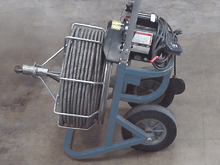
Electric drain cleaners, also called plumber's snakes, use the mechanical force of an electric motor to twist a flexible cable or spring in a clockwise direction and drive it into a pipe. Electric drain cleaners are commonly available with cable lengths of up to 40 metres and can go as far as 80 metres.
Advantages of electric drain cleaners include the ability to clean long sections of sewer drain, the ability to remove solid objects such as tree roots and jewelry, and ready availability through hardware stores and tool rental counters. Machines using springs can easily negotiate multiple 90-degree bends while maintaining their effectiveness and without damaging the pipe.
Disadvantages of electric drain cleaners include high relative cost and weight, and the considerable physical effort that may be required to control the cable.
Safety considerations for electric drain cleaners include the requirement to wear work gloves and eye protection, to carefully control the cable during operation to avoid overstressing it, to use appropriate caution when working around rotating machinery, and to use properly grounded electrical outlets.[15]
Sewer jetters
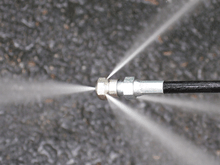
Sewer jetting is the process of shooting high powered streams of water through the drain, down into the sewer in order to blast away any debris blocking the passage of water. This is more effective than using a snake, blades, or even drain rods because, first the water is shot at such a high intensity that the force isn't even comparable to manual labour, secondly the water is much more capable of bending around curved or angular pipes to reach all the tight spots.[16]
A sewer jetter is composed of a controlled high-pressure water source such as a pressure washer or reciprocating displacement pump, a flexible high-pressure line (called a jetter hose which connects the high-pressure engine to the mini-reel) of up to hundreds of metres (several hundred feet) in length, the Mini-Reel (a hose reel which can be taken a distance from the engine) and a nozzle that uses hydraulic force to pull the line into sewer drains, clean the sides of pipes, and flush out residue. High-pressure sewer jetters can be mounted on trolleys, inside vans or on trailers. The power of a sewer jetter ranges from 1,000 psi (68 atm) to 5,000 psi (340 atm). Sewer jetter nozzles come in different sizes and applications; a bullet-type nozzle with a streamlined profile can clear a hole for the larger root cutting nozzle. Root-cutter nozzles are designed to cut roots with a spinning nozzle that shoots a jet stream horizontally inside the pipe. High pressure sewer jetters with root-cutting nozzles can clear a hole through the center of a root-infested sewer line and with its rear-facing jet streams cut the roots and clean the pipe walls, flushing the root debris through the sewer line. The sewer jetter has been labeled as a technological advancement of the plumber's snake (also known as an electric eel) drain clearing method.
Portable sewer jetters and pressure washer sewer jetter attachments are primarily used by service personnel and homeowners to remove soft obstructions throughout the length of a building's sewer drain and to prevent the recurrence of clogs by cleaning the sides of drain pipes and flushing out residue. Pressure washer sewer jetter attachments are generally lower in cost and weight than electric drain cleaners with an equivalent reach, and can present a lower risk of scratching plumbing fixtures.[17]
Truck and trailer-mounted sewer jetters used by municipalities and larger service companies benefit from the high hydraulic horsepower delivered by powerful displacement pumps and so can remove tree roots and other solid obstructions.

Advantages of sewer jetters include the relative ease of penetrating long sewer lines and the ability to remove residue that accumulates along the sides of sewer pipes, thereby reducing the need for subsequent drain cleaning.
Disadvantages of pressure washer sewer jetter attachments and many portable jetters include an inability to extract tree roots and other hard obstructions. Disadvantages of truck- and trailer-mounted sewer jetters include high relative cost and weight, and the requirement for extensive training to comply with manufacturers' safety guidelines.
Safety considerations for sewer jetters include a requirement to wear protective gloves and eye protection, to avoid contact with sewer drain fluids, and to ensure that the jetter nozzle operates only inside the sewer pipe.[18] Furthermore, larger truck- and trailer-mounted units that operate with sufficient power to cut tree roots require extensive training and strict adherence to manufacturers' safety guidelines to avoid serious injury.[19]
Enzymatic drain cleaners
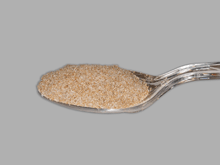
Enzymatic drain cleaners contain bacteria cultures and concentrated enzymes that react with organic residue that builds up on sewer pipes, dissolving the residue to help prevent slow-running drains. Most enzymatic drain cleaners are intended for general maintenance to maintain proper flow and are not intended to clear fully clogged drain pipes.
Advantages of enzymatic drain cleaners include relative safety for use in a wide range of plumbing fixtures, low environmental impact, low cost and ease of use.
Disadvantages of most enzymatic drain cleaners include longer cleaning times compared to most other drain cleaners. Because enzymatic cleaners rely on liquid flowing through the pipe to disperse, they are also generally not intended to open completely clogged drains.
Safety considerations for enzymatic drain cleaners include a requirement to avoid contact with eyes and prolonged contact with skin.
A 1997 blind study of 48 septic systems with three additives, The Effect of Bacterial Additives on Septic Tank Performance [20] found no statistically significant difference in performance from an untreated system, including the buildup of sludge and scum.
References
- ↑ "Chemical Drain Cleaners: Should You Use Them to Unclog Drains?". Scotto Plumbing. Retrieved 5 July 2014.
- ↑ "How drain cleaner is made - material, manufacture, history, used, steps, product, History, Raw Materials". www.madehow.com. Retrieved 2016-12-25.
- ↑ "Sulphuric acid drain cleaner" (PDF). herchem.com. Archived from the original (PDF) on 2013-10-29.
- ↑ Material Safety Data Sheet, "Liquid Fire" Drain Line Opener, September 2007 Archived July 24, 2011, at the Wayback Machine.
- ↑ www.drano.com, "The plumbing configuration of toilets is not conducive to using drain clog removers..."
- ↑ Drano Clog Remover Liquid Material Safety Data Sheet, 30 November 2009
- ↑ "My face melted when drain cleaner exploded". 3 July 2010. Retrieved 4 April 2012.
- ↑ "Are chemical drain cleaners putting your family at risk?". Sydney blocked drain experts. Retrieved 2018-03-06.
- ↑ https://www.cbsnews.com/news/herbert-rodgers-dead-estranged-wife-carmen-tarleton-face-transplant/
- ↑ https://www.quimbee.com/cases/drayton-v-jiffee-chemical-corp?ab_popup=true
- ↑ "Prevent pipes bursting". Retrieved 1 May 2018.
- ↑ Drain Cleaner and Opener Information, DoItYourself.com.
- ↑ Strutner, Suzy (February 26, 2015). "How To Unclog A Toilet Without A Plunger". Huffington Post. Retrieved 7 November 2017.
- ↑ Titow, W. (1984). PVC Technology. London: Elsevier Applied Science Publishers. ISBN 978-0-85334-249-6.
- ↑ Ridgid K-7500 Drain Cleaning Machine Operator's Manual Archived February 6, 2010, at the Wayback Machine.
- ↑ name="Draincare Systems 2018-01-02">"Drain Jetting". Draincare System LTD. Draincare Systems. 2016-04-26.
- ↑ www.sewerjetgazette.net, "How to Unclog a Sewer Drain with Your Pressure Washer"
- ↑ www.sewerjetgazette.net, "Sewer Jetter Safety"
- ↑ , "Sewer Worker Killed by Jet-Vac," Iowa FACE Program Submission, 23 March 2000
- ↑ Clark, Gregory Henton (1997). "The Effect of Bacterial Additives on Septic Tank Performance" (PDF). North Carolina State University. Retrieved 5 November 2017.